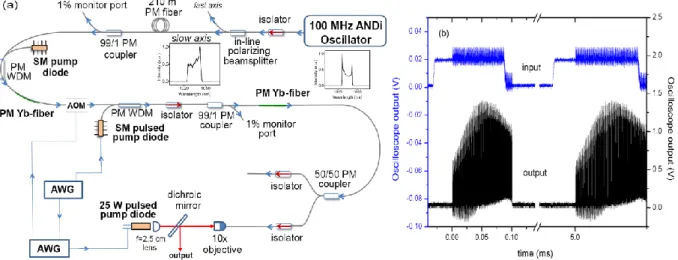JW2A.81.pdf CLEO Technical Digest © OSA 2012
Burst-mode Yb fiber amplifier producing 40 µJ individual
pulse energy
Hamit Kalaycıoğlu1, Y. Burak Eldeniz2, F. Ömer Ilday1, Koray Eken3 1Department of Physics, Bilkent Universty, TR-06800 Ankara, Turkey 2Department of Electronics Engineering, Ankara University, Ankara, Turkey
2FiberLAST Ltd., TR-06351, Ankara, Turkey
Abstract: We report 40-µJ individual pulse energy for 100-ns long amplified bursts with homogenized energy distribution from a 1-kHz Yb-fiber amplifier. Initial results on micromachining using burst-mode femtosecond pulses are presented for the first time.
OCIS code: (060.3510) Lasers, fiber; (140.0140) Lasers and laser optics; (140.3280) Laser amplifiers
There is much interest in fiber amplification of femtosecond and picosecond pulses, which offers certain advantageous features, including low-cost, highly robust and high-gain amplification as well as low added-noise. There are a number of applications covering diverse areas of science, such as photoinjector drive and beam diagnostics lasers in accelerators and combustion diagnostics, that would benefit from a pulse pattern in the form of a group of closely and uniformly spaced pulses, i.e., a pulse burst, which is repeated at a low rate (in the kHz range). Particularly, material and tissue processing applications can benefit from the low effective repetition rate to better manage thermal effects and the momentarily high repetition rate during the burst for high efficiency ablation, with the potential to increase material removal rates by an order of magnitude, while preserving the advantages of femtosecond operation [1-3]. However, to date, only picosecond and longer pulses have been utilized in the burst mode for micromachining applications. Due to the slower material ablation rates obtained with femtosecond pulses, the potential utility of the burst mode is highest for femtosecond pulses.
Fig. 1. (a) Schematic diagram of the burst-mode Yb-doped amplifier, AWG: Arbitrary waveform generator (b) Input and output pulse train (signal burst 100 µs, pump pulse 120 µs, signal lagging pump by 30 µs, rep. rate 200 Hz) demonstrating synchronous pumping.
Here, we demonstrate, for the first time to our knowledge, low-repetition rate, burst-mode operation of a Yb-doped fiber amplifier and its use in micromachining in the burst mode with femtosecond pulses. The laser system produces a burst energy of 400 µJ at a repetition rate of 1 kHz with an average energy of 40 µJ per pulse. The uniformity of the pulse energy within the burst is improved to 7% standard deviation from the average pulse energy through adaptive preshaping of the seed. Bursts of compressed pulses of 8 µJ individual energy and 500 fs duration were applied to a silicon substrate and the potential of the system for micromachining was successfully demonstrated. The experimental setup (Fig. 1(a)) consists of an all-normal dispersion (ANDi) laser oscillator seeding two stages of core-pumped fiber pre-amplifiers, a double-clad (DC) fiber power amplifier as well as synchronized pulse picking and pulsed-pumping electronics based on a fiber-integrated acousto-optic modulator (AOM). The power amplifier incorporates a backward-pumped 20/125 DC Yb-fiber and operates in a pulsed pumping mode with a peak pump power of 21 W. Synchronous pulsed pumping supresses ASE generation due to high gain applied to the low-repetition rate signal (Fig. 1 (b)).
The system is able to produce 400 mW of average power at a burst repetition rate of 1 kHz, with burst duration of 100 ns and pulses in each burst, this corresponds to an average individual pulse energy of ~40 J. The
JW2A.81.pdf CLEO Technical Digest © OSA 2012
autocorrelation result for compressed pulses of 20 µJ shown in Fig. 2(b) indicates a duration of ~400 fs (consistent with numerical simulations (inset (ii) of Fig. 2(b)), assuming a de-convolution factor for a Gaussian pulse. At high-energy operation, depletion of the gain during the burst nominally leads to significant variation in pulse energy across the burst. Homogenization of the pulse energy inside the burst is possible by optimizing the ramp signal applied to the AOM. Fig. 3 (a)-(c) shows the results of adaptive preshaping towards more uniform energy distribution. Discounting the effect of the slow AOM response (30 ns of risetime), in Fig. 3 (a), the standard deviation from the mean pulse energy of 13 µJ is 50%, while in Fig. 3 (b) it is reduced to 23% and in (c) further to 7%, from the average pulse energy of 18 µJ in both cases.
Fig. 2. (a) Amplified pulse burst of 100 ns duration and average individual pulse energy of 40 µJ, (b) autocorrelation result for 20 µJ pulses.
Fig. 3. The 150-ns long high-energy pulse trains demonstrating the improvement in energy distribution across the burst.
Fig. 4. Surface structures on Si substrate formed by application of burst of 14 pulses with 8 µJ individual energy.
We present preliminary results to micromachine with amplified pulse bursts (Fig. 4). The hole and the trench are formed by the application of 150-ns long amplified bursts repeated at 1 kHz and each containing ~14 pulses. The individual pulse energy is 8 µJ and the spot size is 30 µm. Efforts are under way to make a comparison of the micromachining efficiency for the burst mode to the equivalent uniform repetition rate of the laser to assess the effects of burst mode operation.
In conclusion, we have developed the first fiber-based microjoule-energy burst-mode amplifier producing femtosecond pulses. In addition, we are presenting results on micromachining with the burst-mode for the first time, to our knowledge, for femtosecond pulses.
[1] L. Mckinney, F. Frank, D. Graper, J. Dean, P. Forrester, M. Rioblanc, M. Nantel, R. Marjoribanks, CLEO, JTuD9 (2006). [2] W. Hu, Y. C. Chin, G. King, Appl. Phys. A 98, 407 (2010).

